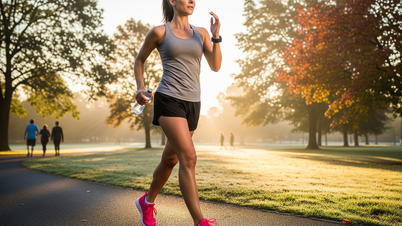1. Walking on your toes
- 1. Walking on your toes
- 2. Walking on heels
- 3. Hip rotation walking
- 4. Walk side to side
- 5. Walking backwards
Toe walking focuses on posture and balance, can strengthen the calves, improve the overall alignment of the body. This simple exercise works the muscles of the legs, especially the shins, and helps correct posture.
Practicing toe walking or walking on your toes for a minute or two each day can reduce stiffness in your feet and improve your posture. Balancing on your toes requires concentration and core engagement. Over time, toe walking can help improve stability and strengthen your leg muscles without the need for any equipment.

How to do toe walking.
2. Walking on heels
This walking style targets the lower legs and is especially beneficial for people who sit for long periods of time; it helps stimulate blood circulation and strengthen the ankles. It activates the muscles in the front of the legs, promoting better circulation and reducing swelling or water retention in the feet.
Additionally, heel walking improves balance, aids joint flexibility, and can help reduce stiffness caused by prolonged inactivity, making it a great exercise for office workers or those with sedentary lifestyles.
Heel walking can be a simple remedy for tired feet after a long day at work. Incorporating this exercise into your daily routine can help prevent ankle weakness and improve balance, making it a valuable daily exercise.

Image of heel walking.
3. Hip rotation walking
Hip rotation walking is designed to loosen tight hip muscles and increase flexibility. Many people suffer from stiffness in the lower back and hips due to prolonged sitting or lack of movement. This walking style focuses on gently rotating the hips while walking, allowing the joints to move freely and releasing built-up tension.
Just one minute of hip rotation walking can make a significant difference in flexibility and posture while promoting smoother movement of the spine and hips, improving comfort during daily activities. Over time, this type of walking can also help reduce back pain and promote a more relaxed gait.

Hip rotation walking.
4. Walk side to side
Side-to-side walking strengthens the inner and outer thighs and improves coordination. By moving side-to-side, the body engages muscles that are often neglected during normal walking, helping to tone the thighs and hips while also increasing stability, which is essential for maintaining balance as the body ages.
This type of walking can be done at home in a small space, making it ideal for those with limited space for exercising. Regular practice can improve lower body strength and overall endurance, while also making the body more agile and energetic.

Walk side to side.
5. Walking backwards
Walking backwards is an effective exercise to protect your knees and improve joint health. Walking backwards may feel strange at first, but it strengthens the muscles around your knees and improves coordination.
Walking backward for just two to five minutes a day can help prevent joint pain, improve body awareness, encourage the use of different muscle groups and challenge your balance, providing a fresh way to move your body.

Walk backwards.
Source: https://suckhoedoisong.vn/5-kieu-di-bo-hang-ngay-giup-khoe-khop-tang-cuong-su-deo-dai-169251105123251266.htm


![[Photo] Chu Noodles - the essence of rice and sunshine](https://vphoto.vietnam.vn/thumb/1200x675/vietnam/resource/IMAGE/2025/11/11/1762846220477_ndo_tl_7-jpg.webp)




![[Photo] Prime Minister Pham Minh Chinh chairs a meeting on housing policy and the real estate market.](https://vphoto.vietnam.vn/thumb/1200x675/vietnam/resource/IMAGE/2025/11/11/1762838719858_dsc-2107-jpg.webp)
























































































![Dong Nai OCOP transformation: [Article 4] Reaching national standard products](https://vphoto.vietnam.vn/thumb/402x226/vietnam/resource/IMAGE/2025/11/11/1762825820379_4702-cac-san-pham-trai-cay-chung-nhan-ocop-nongnghiep-174649.jpeg)



![Dong Nai OCOP transition: [Article 3] Linking tourism with OCOP product consumption](https://vphoto.vietnam.vn/thumb/402x226/vietnam/resource/IMAGE/2025/11/10/1762739199309_1324-2740-7_n-162543_981.jpeg)






Comment (0)